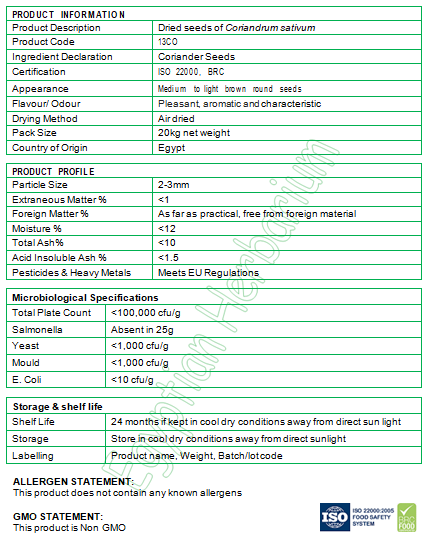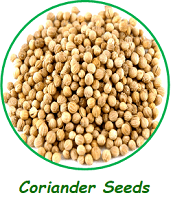-
CORIANDER Seeds
- Botanical Name: Coriandrum sativum
- The fruit is a globular, dry schizocarp 3–5 mm (0.12–0.20 in) in diameter. Fresh leaves and the dried seeds are the parts most traditionally used in cooking. It is used in cuisines throughout the world. The seeds have a lemony citrus flavor when crushed. It is described as warm, nutty, spicy, and orange-flavored. Roasting or heating the seeds in a dry pan heightens the flavor, aroma, and pungency. Coriander seed is used widely in the process for pickling vegetables and used while making sausages. In Russia and Central Europe, coriander seed is an occasional ingredient in rye bread (e.g. Borodinsky bread), as an alternative to caraway. The Zuni people of North America have adapted it into their cuisine, mixing the powdered seeds ground with chili and using it as a condiment with meat, and eating leaves as a salad. One preliminary study showed coriander essential oil to inhibit Gram-positive and Gram-negative bacteria, including Staphylococcus aureus, Enterococcus faecalis, and Escherichia coli. Coriander is listed as one of the original ingredients in the secret formula for Coca-Cola.
- About half a litre of coriander mericarps was recovered from the tomb of Tutankhamen, and because this plant does not grow wild in Egypt, Zohary and Hopf interpret this find as proof that coriander was cultivated by the ancient Egyptians.
- Nutrition: Raw coriander leaves are 92% water, 4% carbohydrates, 2% protein, and less than 1% fat(table). The nutritional profile of coriander seeds is different from the fresh stems or leaves. In a 100 gram reference amount, leaves are particularly rich in vitamin A, vitamin C and vitamin K, with moderate content of dietary minerals (table). Although seeds generally have lower content of vitamins, they do provide significant amounts of dietary fiber, calcium, selenium, iron, magnesium and manganese
- Storage: Keep tightly covered and store them in a cool, dry place. Whole spices stay fresh for up to 2 years while ground spices have a 6-month shelf life. Store red spices, such as paprika and red pepper, in the refrigerator. They will hold their color and keep their flavor longer.
| PROCESSING | PACKING | 20' FCL Load | 40' FCL Load |
| Seeds, whole | PP Bags, 25 kg | 12,500 kgs | 25,000 kgs |



